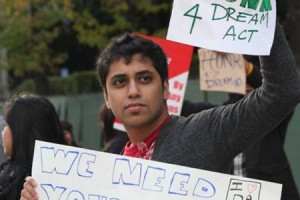 I’ve been following closely the case of Minhaz Khan, a 24 year old undocumented Bangladeshi-American from the Inland Empire who, on Nov 4th, was required to put on an ankle bracelet and present a one way ticket to Bangladesh to the authorities. It had been 20 years since he’d been to Bangladesh and when his father was deported after being denied political asylum, he was murdered for his political affiliations in Bangladesh. DreamActivist.org had a petition out to support his case and his case garnered local media coverage. His case officer read the coverage and removed the bracelet last week and Minhaz last Tuesday was granted a temporary stay.
I’ve been following closely the case of Minhaz Khan, a 24 year old undocumented Bangladeshi-American from the Inland Empire who, on Nov 4th, was required to put on an ankle bracelet and present a one way ticket to Bangladesh to the authorities. It had been 20 years since he’d been to Bangladesh and when his father was deported after being denied political asylum, he was murdered for his political affiliations in Bangladesh. DreamActivist.org had a petition out to support his case and his case garnered local media coverage. His case officer read the coverage and removed the bracelet last week and Minhaz last Tuesday was granted a temporary stay.
Minhaz Kahn — the UC-Riverside alumnus who last week had to show immigration officers that he bought a one-way ticket back to his native Bangladesh — learned Tuesday that he doesn’t have to return home just yet. He will be able to stay in the country for another three months…[T]op federal counsel told a group of American Immigration Lawyers Association attorneys in a meeting last week that they will not automatically grant a stay for all other DREAM Act eligible immigrants who are awaiting deportation, says AILA attorney Leah Price. [SFWeekly]
I had the chance for a virtual sit-down with Minhaz right after the ankle bracelet was placed on him a couple of weeks ago. Here’s what he had to say.
When and why did your family come to the United States?
My family came in 1992 to flee danger. My dad left entrepreneurial success and political influence to work at gas stations and my mom left a teaching career and lost all significance her Master’s held, so to anyone who says immigrants come here to take anything from anyone is missing what many people have to leave behind for safety and the possibility of a better future.
Why wasn’t your father able to seek political asylum? What happened after he was deported?
I’m not completely sure why he wasn’t granted asylum. I never got to see the judge’s decision, but I think he missed an interview or something due to a lawyer not notifying him. After he was deported in 1997, he died (or in my whole-hearted belief, murdered) a couple of years later. Continue reading



